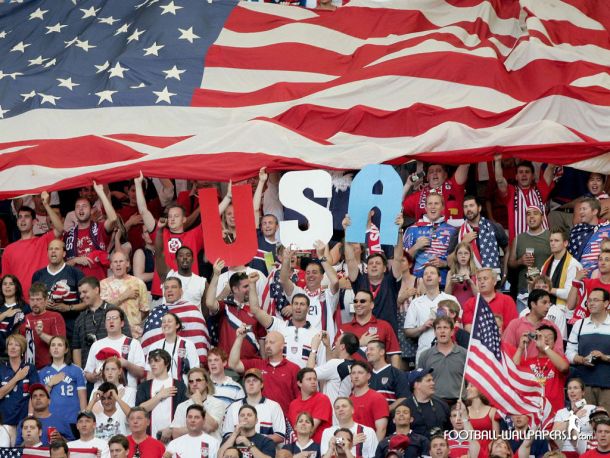People in America have embraced the drama of promotion and relegation in England, Spain, Italy, Argentina, Mexico, and many other countries. It's something that happens in every professional league in the world outside of the United States. With the English relegation battles going mainon the NBC family of networks, demand has never been higher for promotion and relegation in our United States sports.
Promotion and relegation offers major reasons for fans to still tune into their teams, particularly if they are far away from the top of the standings. Like that hope of recovering the dues one paid for fantasy football this season, owners in a promotion and relegation system have to stay involved with their team, and make the necessary changes, if not drastic shakeups, just to keep their club in their league. The costs of not doing so--relegation to a lower league, a full-scale transfer of players out of (often on high wages/salaries, or who have significant value on the transfer market) and into the team, and losses in TV and gate revenue--are often higher than the costs of making those wholesale changes.
And as Daniel Gross so eloquently states in his wonderful piece in Slate, this sort of system feeds more into the American way of doing things than the supposedly more socialist/protectionist franchise/single-entity/limited-membership system in American pro sports, which also denies fans a major reason they tune into sporting events--to see greatness (which is hampered by salary caps, single-entity, and so-called "parity"). (Second point, although the UFC has gained popularity over the years--people still are willing to pay $75/pay-per-view, and do so without question, to see greatness and superfights--whether it's Floyd Mayweather's and his intellectual brand of boxing, Manny Pacquiao, or Miguel Cotto.) Even given his points, and that anyone can form a team any time, there are many real obstacles to implementing promotion and relegation on a USSF (US Soccer Federation) wide scale--unifying the pyramid, and providing clubs the same opportunities that boxers have--to fight their way up the ranks and one day be "the greatest team in the world," if not the USA.
1) USSF must negotiate league-wide TV contracts for each of its tiers with nationally-available networks.
Currently, MLS teams sign contracts with regional sports networks (RSNs) that are only available in the teams' local markets. Signing contracts with these RSNs may be contingent on teams staying in the top flight or the top few tiers. But since no second or third division side (as far as this writer knows...feel costless to correct him if he's wrong) has a RSN TV contract, it can be implied that RSN contracts are dependent on teams being in top flight year-in and year-out, and are thus a benefit of a closed system.
In an open system, the localities of the teams change with each year. Sometimes, there may be 5 teams from one area (for instance London, Sao Paulo, or Buenos Aires) and 0 teams from other areas (Amazonas in Brazil, and the North East in England). So, the leagues, from the top flight (whether that is still MLS or a new USSF Division 1, or NASL/USSF Division 2, etc.) have to sign TV contracts with national providers who can THEN divvy up the matches to make sure, at least on paper, that each local market receives X number of games, including that of the team(s) nearest to the local market. This implies signing with a costless-to-air network like CBS, NBC, FOX, or ABC, or a basic-tier pay network like ESPN--and local affiliates and markets deciding what games they are going to carry. Essentially, what games are covered could look like the maps 506 Sports regularly provides (Follow them on Twitter), with options for out of market, or secondary games within the same market for those areas with lots of teams in the league of choice.
We could also see multiple networks take up different priorities of games--a la Sky Sports getting the first choice of BPL games followed by BT--analogous to NBC taking the first choice of matches, with FOX and ABC taking second and third choices of matches. The more choices available, the more they can cover for multiple teams being within the same media market, and potentially conflicted loyalties of certain markets (Patriots fans in South Florida, which should be a Dolphins market.) It puts the league in more homes, and allows people from outside of the RSNs' reach to support a team in the league.
Besides expanding the bases of the teams' beyond the RSNs, it gives people the chance to support multiple teams. One such phenomenon is Brescia fans (Brescia is a suburb of Milan) supporting Milan sides in Italy's Serie A and Brescia in smaller leagues because Brescia has rarely played in Serie A on a huge stage. In the USA, you might see a situation where someone might support Manchester United in their quest to experience greatness, but support the New York Cosmos closer to home--and willing to bear the pains of the Cosmos' journey up the USSF ladder. In a promotion/relegation situation, it might mean someone supporting DC United on the top-flight level, but supporting the Cosmos or Nashville FC closer to home. This is depending on where "closer to home" is. Removal of RSNs will allow people to experience and support multiple teams in the pyramid, because the national networks' abilities to show teams that would not be able to be viewed on RSNs.
It also allows for lower tier leagues to seek TV contracts that would improve their visibility, and to showcase their dual dramas of both the promotion fight to higher tiers and the relegation fight. Those dramas, rather than the dramas of "playoff fights" or "Soccer Bowls" may draw American sports fans now used to the concept of promotion and relegation, as well as non-sports fans simply looking for drama on TV. Oh, and there are plenty of nationally-available TV networks and internet networks that would pick up even the lowest of tiers on the national pyramid.
2) The USSF must decide on a way to foster player development within the pyramid without turning half the pyramid into a FMF-style minor league system.
One of the big conundrums of promotion/relegation is how to develop young players, particularly those in the "young pro" range of 17 to 21 years of age. We have seen in MLS where teams have refused to give some players like Victor Pineda or Omar Salgado the match time they need in order to develop as players. Where USA lags behind other countries is in this critical age group. Often times, the college season does not offer enough games or development time for players. So, in order to keep up their skills, many players have to find clubs in the PDL, USASA, or USL Pro to keep the skills they have--or sign onto MLS (or even NASL) sides only after a year of playing college soccer. We tend to associate "one-and-done" to college basketball players projected to be lottery picks in the NBA Draft, but this is just as common, if not more common, in soccer.
If nothing is done about giving players game time, teams may be more likely to sign veteran players who understand the role their club is in, or play a much more physical style of soccer as to disrupt the flow of the match in the hopes of getting points from 0-0 draws, etc, and deny young players the technical environment they need to develop. Many leagues, including MLS, feature reserve leagues to feature players that don't regularly feature for their club sides. But, like in the USA development system, young players that play there only play against players of similar age, and not against pros--and they continued to be sheltered away from what they need to do as pros.
One way MLS teams have started to try to get playing time to out-of-favor players would be to loan them to other sides (though not yet within MLS). These could be loans teams in NASL or USL Pro. Much is noted elsewhere of MLS teams affiliating with particular USL clubs to loan young players for further development. But technically, the USL Pro or NASL club has no incentive to play and develop the loaned player if they see the loan as only temporary. If they intend to buy the player, a different story. And there could be situations where some clubs loan so many players to one side that the other sides complain about facing a "minor league side" (e.g. Udinese loaning lots of players to Watford in the Football League Championship, Chelsea loaning 6-8 players to Vitesse in the Eredivisie).
Some federations get around this by allowing reserve sides to compete in the same pyramid as the more senior sides--as seen in Spain, Germany, and Portugal. Reserve sides (known as B-squads or C-squads, or II-squads) compete in the pyramid, but cannot compete in the same flight (or a higher flight) than the senior team. But typically, without the hope of playing top flight soccer, reserve sides draw significantly less people than do the senior sides that their level. (For example, a typical Segunda Liga attendance might be around 10,000 fans. FC Barcelona B and Real Madrid B only draw in the hundreds of people to see the young Blaugranas or Merengues). On the positive side. these players do face full-time pros (or semi-pros) and experience the thrills and spills of promotion and relegation first hand.
But if the notion of playing reserves means that there are at least 8 or 9 teams in a second division of 20 teams that are "affiliated" or "reserve clubs," it denies spots for teams that see their ambition as top-flight soccer, and makes a mockery of the pyramid. (This can occur at any level, I just picked out the second tier as an example.) It also forces teams to try to use promotions (like giveaways, fireworks nights, costless tickets, etc.) and marketing to lure fans, which implies that the product is not good enough, nor are there any reasons for people to care naturally about the lower tier.
Co-ownership, in which a team may loan a player out--and 50% of the transfer rights of the loaned player--to another team, whether within the same division or a lower division, may solve the development issue while providing incentives for a team to play the loaned player. The incentives turn out to be money from the transfer fees paid for that player, if the player becomes good enough to be wanted by another team. Or a team could money on the player in two successive increments--a transfer fee paid at the start of the loan out (or co-ownership out) period, and one if the player's new team wants to buy the rest of the loaning team's rights. In a business sense, it may allow a team to profit off of developing a player on loan. But this does not preclude that a player cannot be released by one of his clubs, that there aren't rights disputes over the players (which are solved by secret bidding), or that the player can't go off to a third club on loan. And another drawback of this type of loan could be that the destination team may have to pay the player's wages. But this drawback could potentially be small in comparison to the benefits.
3) There simply aren't enough professional teams competing in the USSF, and enough soccer-amenable stadia
This is one argument the MLS people have right. There simply aren't enough professional teams, and teams with stadiums the size of MLS-size stadiums or bigger (nor are playing on grounds primarily set up for soccer). There may be only 40 or so professional teams between the top three divisions of the US Soccer pyramid, and not all of these are based in the United States. Perhaps one of the reasons for MLS asking for huge expansion fees out of new owners could be that MLS wants those owners commit that money to building the proper club infrastructure, stadia, offices, training facilities, as well as soccer academies (at various levels) and clinics.
The barrier for NASL, USL Pro, NPSL, and PDL teams is much lower than those for MLS. But if there is promotion and relegation, it would be very hard on the eyes to see a team playing in a 70,000+ seat capacity stadium in third or fourth division, where most other teams feature stadia with <10,000 seat capacities. Even in MLS, those large stadia are eyesores when <30,000-40,000 people show up to the game. Teams can close off parts of their stadium, but that only adds to the need for more intermediate sized stadiums in between the 5,000 seat stadiums and the 70,000 seat football-sized stadia so taems could change grounds accordingly without moving too far.
But we may be surprised, as with Rangers, that 70,000 fans could come support their team in the lowest levels of the USSF pyramid, if the team manages to accrue enough history, has a strong enough identity, and has a traditional winning identity that the supporters still believe in even though their club may be on hard times.
We may also be surprised with the numbers of teams that may sign up to the cause of professional soccer, and the hopes of one day playing for trophies at the MLS (or Division 1) level. But many of those teams, without proper guidance or criteria on what sort of facilities the teams may need to enter a particular ranks, or minimum requirements for professionalization, most of these teams could either remain too amateur for too long (if they move up the pyramid), or shutter because of either not knowing the costs of playing pro soccer or wanting to develop their own players.
We could greatly expand the number of semi-pro and pro teams in the USSF system by just giving a way for the thousands of traveling youth teams to professionalize. They already contain a developmental infrastructure and training and match grounds. The phenomenon of "pay to play" (another common problem throughout the US Soccer pyramid) could easily end if these youth clubs are convinced that fielding adult/professional teams are a big enough revenue source to no longer collect fees from parents for having their kid(s) play for the team. Of course, some teams may not take the bait. But the USSF pyramid does not necessarily need every traveling youth club and US Club Soccer to make the USSF pyramid healthy.
Those numbers could come from USASA and US Club Soccer (adult level), who already field adult teams, but may need to field developmental teams at lower age levels. Likewise, those requirements (as well as requirements for permanent grounds) could be made if the team moves up into what is determined as the "professional ranks." This is a marker that isn't necessarily static. It could easily change as more teams professionalize, and it could be at some cutoff either within the regional ranks (to prevent amateur teams from having to think about national travel) or as criteria to move up from the regional leagues into the national league.
All of these does not even include how to handle University-sponsored teams (who already have their own association and rules). However, if those teams are incorporated, it would have to take significant legal challenges to the NCAA or NSCAA in order to incorporate those university-sponsored teams. (This is for another day and for other writers to cover.)
4) Whatever the system that is developed, it must encourage local derbies with stakes throughout the pyramid.
However the USSF pyramid forms when we have promotion and relegation, it must encourage local derbies. One of the lacking features in US Sports, particularly outside of the Northeast metropolitan areas, is the lack of local derbies--rivalries between teams that are located near each other that often represent different demographics/neighborhoods in the same metropolis. It is a way for people to "rep their hood" and show local pride--and for fans to push players. Players also understand that local derbies mean everything to the fans, and are more likely to put more into the match than they otherwise would. If developed, they become cultural events which will draw people in no matter what the stakes actually are. Or if there are stakes, the atmosphere get that much better (and intimidating).
Local derbies are to international soccer what rivalries are to college and high school sport. Being on a side in those fierce rivalries is a part of the local identity. It might come from teams coming from different political classes or movements, or it could come from urban/rural divides, or ethnic enclaves. But it is hard for rivalries to foster between teams that are hundreds to thousands of miles apart. If they become organic because of the stakes and because of time, they equally die when the stakes are not there. And so, the promotion/relegation pyramid system will have to find a way to divide teams into smaler regional pyramids, whether it's for Brazil-style regional leagues (with the leagues being ranked by a mathematical formula, which helps to determine the allocation of teams for some national tournaments, similar to Conference RPI or BCS in college sports, or the IFFHS club/league coefficients that reward play in international competitions), with the pyramids branching off by region with each step or couple of steps down.
Perhaps unlimited clubs and reduced barriers of entry may already solve that issue and we may not need the second regional-league pyramid (with which we have to fix the problems of providing games for teams not in the national pyramid). Feel costless to provide suggestions in the comments section or tweet the writer your suggestions.










































